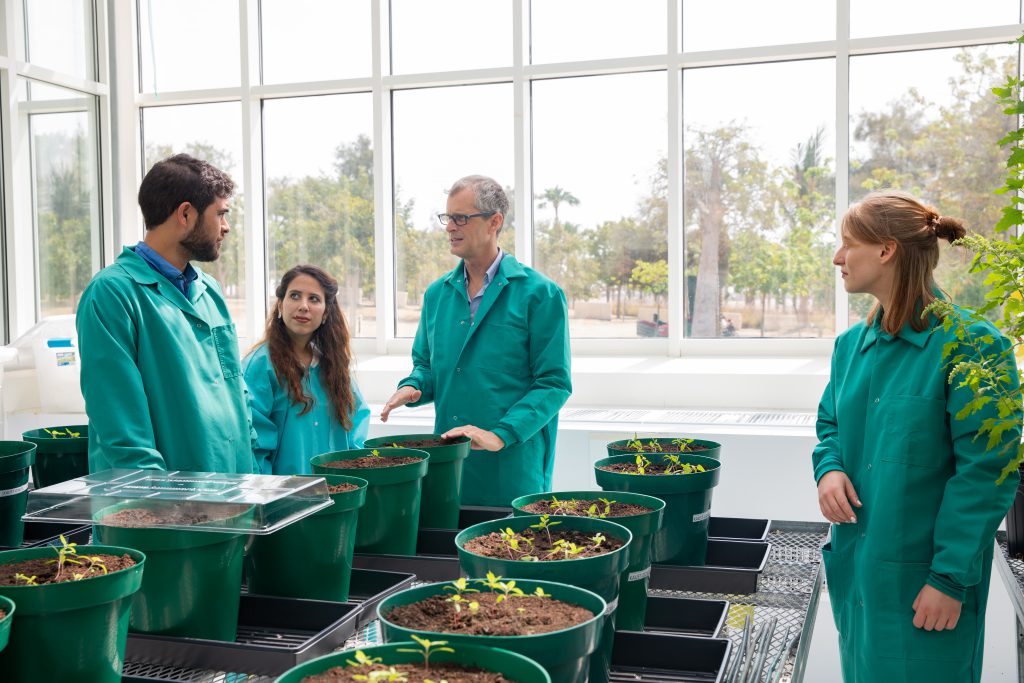In the past 100 years, the average temperature has risen by over one degree Celsius. Already, that’s caused over one-quarter of Saudi Arabians to change their food, energy, and water usage habits. Given traditional agriculture’s massive water requirements, greenhouses seem like a positive solution to stop and reverse some of these problems. But there’s a problem with traditional greenhouses, too.
Greenhouses require a lot of power to maintain the right balance of heat and humidity. And they place an additional drain on the electrical grid, thanks to their need for freshwater. Red Sea Farms is breaking the food-water-energy nexus to create an AgTech solution to climate change and resource scarcity with the help of KAUST (King Abdullah University of Science & Technology).
Agriculture requires energy and cost-intensive desalination
Food, water, and energy are three resources that traditionally form a nexus—that is, they are all intrinsically linked. If you want more food, you have to use more water. If you want to use less energy, you have to create less freshwater, which leads to less food.
Red Sea Farms noticed that traditional greenhouses began to combat this nexus by maintaining the perfect growing environment and reducing freshwater usage to get more food from fewer resources. But there was still a major problem. As water usage and food increase, so do the energy requirements. Traditional greenhouses use large amounts of power to maintain the ideal temperature and humidity level.
And while they do lower the water requirement, they still require a significant amount of freshwater for cooling and for irrigating crops. Since all the needed freshwater is made through desalination, Saudi Arabian greenhouses have an even higher energy footprint than in other parts of the world.
Red Sea Farms saw this leading to a strain on the power grid and a higher carbon footprint for agriculture—an industry that’s already a leader in greenhouse gas emissions. Plus, desalination is a costly process that raises the cost of food and can make food security a challenge.
Red Sea Farms developed greenhouses that use saltwater and solar power

Red Sea Farms developed a smart greenhouse that takes water and energy savings to the next level by breaking up the traditionally linked food-water-energy nexus. With saltwater, solar power, and advanced greenhouse control systems, they can grow food without the major carbon footprint and energy requirements. Red Sea Farm’s three co-founders bring their backgrounds together to drastically reduce the carbon footprint of crop growth in greenhouses:
Salt-tolerant plants – KAUST Professor, Mark Tester creates organic, pesticide-free produce that can tolerate higher levels of saltwater.
Saltwater cooling – KAUST Research Scientist, Ryan Lefers, designed a way to use saltwater in the cooling systems to reduce the need for desalination.
Advanced heat-blocking glass – KAUST Associate Professor, Derya Baran, developed a new system of greenhouse glass that blocks more heat so that the cooling systems and fans require less runtime and energy.
Smart monitoring systems – Red Sea Farms developed an AI-enabled system that monitors and maintains the greenhouse systems to optimize energy savings and plant growth.
Solar power – Red Sea Farms uses solar panels and solar glass to further reduce the energy impact of their greenhouses.
Together, these systems save approximately 300 liters of freshwater per kilogram of produce grown. And thanks to the solar panels and heat-blocking glass, many greenhouses see drastically reduced energy requirements from cooling as well.
When asked how the saltwater systems work with different crops, Lefers says, “If we want to grow a cucumber in our greenhouse, then it’s cooled with saltwater. But, we still need to desalinate irrigation water because cucumbers are sensitive. But, if we want to grow a tomato, we can cool and irrigate with saltwater. In both cases, we’re still saving both water and energy over other agricultural methods.”
Their greenhouses turn arid environments into centers of agriculture and commerce
Red Sea Farms’ research has moved away from information on paper to tangible products that help feed people. And they continue to contribute to food security, water security, job creation, and economic growth, thanks to KAUST Innovation’s funding and facilities. Lefers says that the about $4 million in funding, the prototyping lab and R+D labs provided by KAUST Innovation Ventures made Red Sea Farms and their impacts possible. He also says that the 2000 square meter R&D greenhouse on campus is vital to the research and development at Red Sea Farms.

In November of 2021, Red Sea Farms was able to partner with the Red Sea Development Company, thanks to the progress made in their greenhouse technology. The goal: build and operate an indoor farm that will sustainably feed everyone at The Red Sea Project. More recently, in January of 2022, Red Sea Farms was able to expand internationally to the U.S. to test out its technology in the arid desert environment.
The mission of Red Sea Farms is to develop a future where Saudi Arabian greenhouses use only sustainable energy and 95% less water. When asked what Lefers sees for the future of Red Sea Farms, he says, “You know, there are a lot of big challenges that we’re facing as a planet today. Climate change, population growth, global supply chain disruptions and the demand for freshwater resources. We can do our small part to contribute some solutions to those big challenges.”
To learn more about Red Sea Farms and how they are changing agtech in Saudi Arabia, visit their website.

